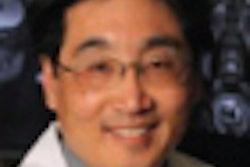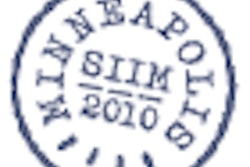SAN FRANCISCO - It seems like each new evolution of CT technology creates a new set of workflow dilemmas for users. But the solution could be as simple as treating CT scanners like IT devices, according to Dr. Paul Chang, who spoke at this week's International Society for Computed Tomography (ISCT) annual meeting.
It's no secret that the CT "slice wars" have put enormous strains on radiology department workflow. The proliferation of large multidetector-row datasets, with thousands of images per exam, has given rise to alternative paradigms for image review, the most prominent of which is advanced visualization.
But even 3D image review hasn't solved the problem -- indeed, it's given rise to a whole new set of issues as radiology professionals get pulled away from traditional tasks and sucked into image reconstruction and review. That has created friction between the radiologists reviewing images and the imaging informatics specialists -- like Chang -- who are trying to give them better tools.
"We've solved the problem for most routine work. But you guys still cause us huge grief, which basically means that you pay the penalty, and that is that your workflow isn't smoothly integrated," said Chang, who is vice chairman of radiology informatics at the University of Chicago. "We need to do a lot better with respect to integration and workflow models to better incorporate your workflow in talking about very large datasets and MDCT studies."
AV and economics
It's not just a theoretical issue, Chang said. Reimbursement cuts have put extreme pressure on radiology, and more are coming down the pike. At the same time, radiology's expectations are growing -- everyone loves the pretty pictures and the value that derives from advanced visualization, he said. Radiology will need to do more with less, and the only way to do that is better integration with IT and informatics.
Unfortunately, radiology tends to focus too much on efficiency in the reading room, as measured by metrics such as patient throughput and report turnaround times. Meanwhile, efficiency outside the reading room has been ignored, Chang believes.
The University of Chicago has been working on a project for the past three years in partnership with Philips Healthcare that it calls the Closed Loop Imaging Initiative, which tracks productivity from when a referring physician orders a study to when they've received the final report. By conducting time-motion studies, researchers found an enormous bottleneck in the scanning suite, with radiologic technologists (RTs) spending approximately 70% of their time on ancillary work -- compared to a best-practice metric of around 30% for their core job, which is providing the safest and most optimal image acquisition.
Researchers attacked the problem through better IT integration in the reading room, specifically by including the modality scanner as an IT device that can both receive and push out data. Fortunately, other industries have already paved the way, serving as a model for IT integration that radiology can emulate through the use of an IT concept called service-oriented architecture (SOA).
Using SOA, patient data in disparate applications such as RIS, PACS, and electronic medical records (EMRs) are pushed out through the enterprise so the information is accessible at multiple locations, and physicians are no longer required to access data through a specific software application. For example, University of Chicago radiologists in the reading room are able to get pathology or lab values data automatically through the PACS, without having to go through the EMR.
"Bottom line is, this is very easy to do," Chang said. "This is standard technology that Amazon, Netflix, your bank, the military ... every vertical [industry] without exception uses this approach with one important exception: us."
How it works
At the University of Chicago, the concept works with the CT scanner gathering the demographic information for the next patient and automatically setting itself up with the most optimal scanning protocols, without intervention from the RT -- reducing error and increasing efficiency. After image acquisition, all postexam functions such as reconstruction and transmission to PACS are done automatically.
The project has reduced technologist turnaround time for a basic scanning protocol from 30 minutes to 10 minutes, a 66% reduction. The same level of reduction was achieved for more advanced scanning protocols such as endovascular aneurysm repair. This all translates into cost savings.
"This means I can incorporate a 45% reduction in technical fees because if I have a backlog, I can double my productivity, or if I don't have a backlog, I can do without half my scanners," Chang said.
In his second talk in the ISCT session, Chang discussed the university's application of the SOA concept to another efficiency roadblock: contrast injector systems. Contrast injector protocols are increasingly complex, and the university's time-motion analysis found contrast management to be another big time sink. The university worked on this aspect of the project with contrast injector firm Medrad.
As with setting CT scanning protocols, SOA allows the radiologist to get all the patient information needed to set the right contrast administration protocols automatically. Radiologists can look at the outcome of prior studies via an analytics tool with hyperlinks to additional data, reviewing contrast protocols and other parameters. If the protocol wasn't performed correctly the last time, it can be tweaked for the next scan via a graphical interface.
What's more, the contrast protocol used for a patient will automatically populate the radiologist's speech recognition report -- saving additional time. Complex contrast protocols can be managed remotely, which is becoming increasingly important in the distributed radiology model that's becoming prominent. And again, the technology to achieve this integration is not complicated.
"This leverages the same kinds of tricks you'd use in the reading room to achieve efficiency and safety, and improve quality in the scanning suite area as well," Chang said. "This is the same kind of approach that we do with the PACS and the RIS, it's just basically treating the CT scanner, the modality, as well as the injector, as IT devices that need to be orchestrated and choreographed to improve efficiency and quality."
AV infrastructure strategies
In his final ISCT presentation, Chang discussed different strategies for setting up advanced visualization infrastructures, again with a focus on the challenge of integrating very large datasets into PACS networks. Chang sees the recent move toward on-demand archive designs -- such as client-server 3D architectures -- as a positive trend in addressing the challenge of transmitting AV datasets.
But the problem now is that many facilities have multiple client-server 3D networks. The solution? Creating what Chang calls intelligent DICOM routers that are smart enough to send modality data to the correct location within the enterprise's network: for example, thin-slice images to a 3D workstation and thick-slice images to a PACS.
All this new technology is great, but in the end, radiologists and IT professionals need to communicate and work together to solve radiology's advanced visualization challenges.
"We really need your feedback because, unfortunately, if you leave it to us IT geeks, we're going to screw it up," Chang said. "We really need some input from you guys to understand how to better incorporate advanced visualization into digital workflow."



















